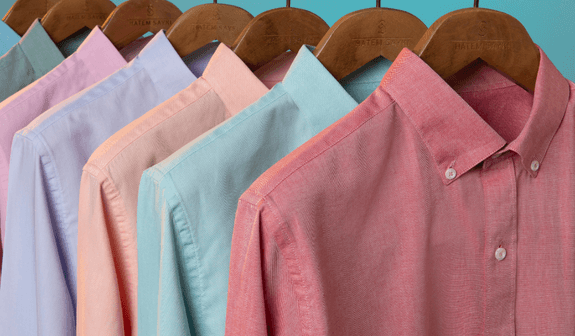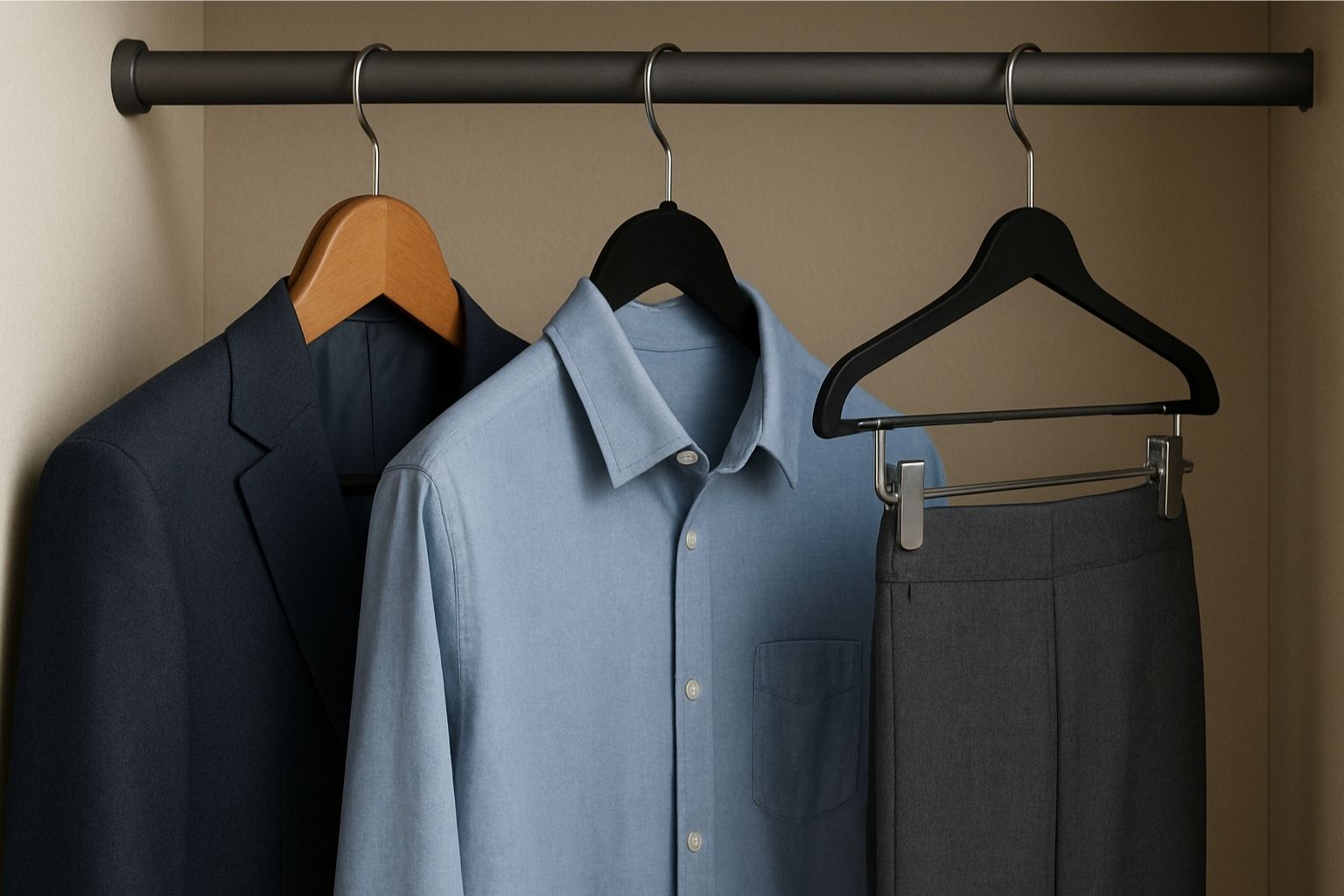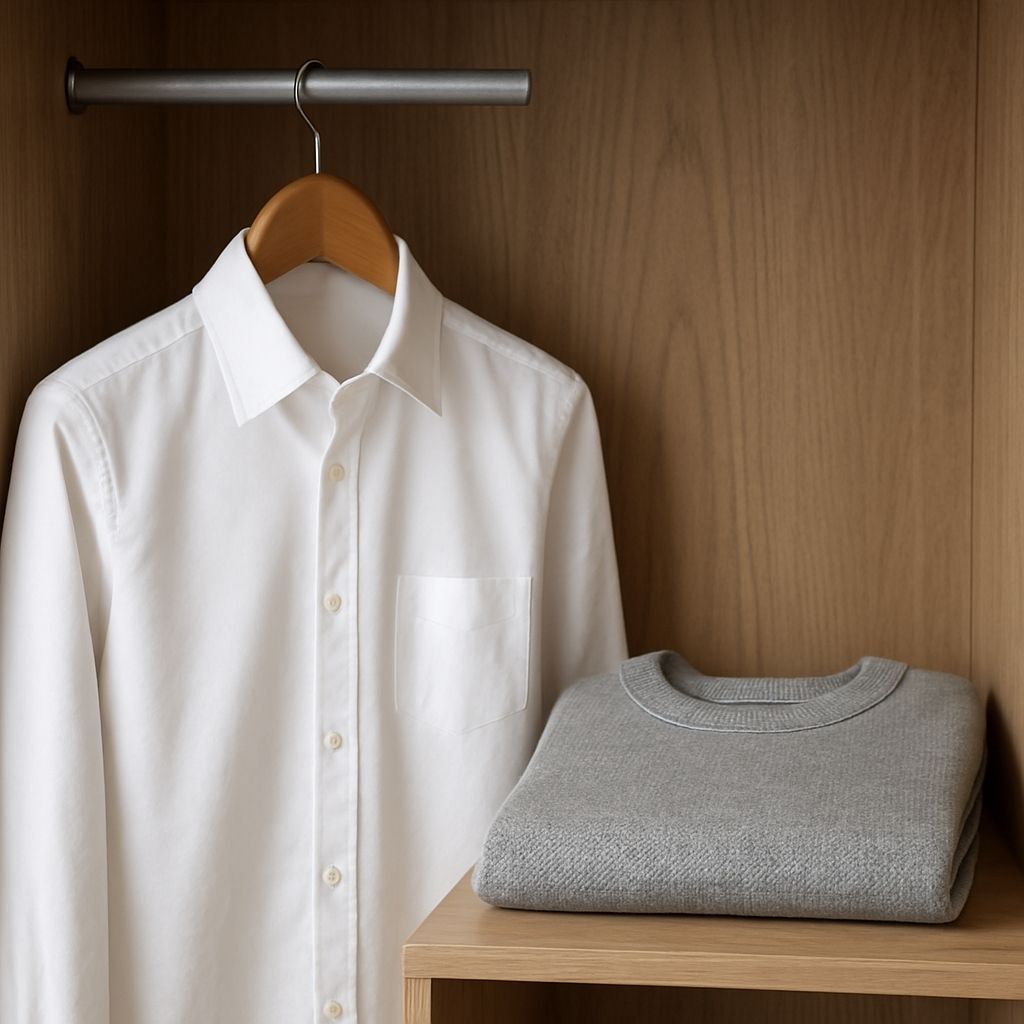A well-organized closet transforms your daily routine from chaotic scrambling to smooth efficiency. Most men underestimate the impact of proper wardrobe organization on their professional image, personal confidence, and time management. Whether you're dealing with a cramped apartment closet or a spacious walk-in, the principles remain consistent: strategic planning beats random storage every time.
Your closet serves as the command center for your personal style. When everything has its designated place, getting dressed becomes effortless, and you'll discover clothing combinations you never noticed before. More importantly, an organized system helps preserve your investment in quality garments, extending their lifespan and maintaining their appearance.

Why Organize Your Closet?
The benefits extend far beyond aesthetics. A systematic approach to closet organization saves valuable morning minutes, reduces decision fatigue, and prevents costly wardrobe mistakes. You'll stop buying duplicate items because you can see exactly what you own at a glance.
Professional benefits include arriving at work looking polished and put-together. When your suit hangs properly wrinkle-free, and your accessories are easily accessible, you project competence and attention to detail. These subtle signals matter in business environments where first impressions count.
Financial advantages become apparent over time. Proper storage prevents damage, fading, and premature wear. Your clothing investment maintains its value longer, and you'll make more intentional purchasing decisions when you understand exactly what gaps exist in your wardrobe.

How Should a Man's Closet be Organized?
The foundation of male closet organization rests on three core principles: accessibility, preservation, and efficiency. Unlike women's wardrobes that often prioritize visual display, men's closets should emphasize quick retrieval and garment protection.
Start by designating zones within your space. Business attire occupies the most accessible area, followed by casual wear, then seasonal or specialty items. This hierarchy ensures your most frequently used pieces remain within easy reach.
Vertical space utilization proves crucial in most closets. Think in layers: hanging rods at different heights, shelving units, and drawer systems that maximize every inch. The goal is creating distinct homes for each category of clothing while maintaining logical flow patterns.
Declutter: Edit and Evaluate Your Wardrobe
Before implementing any organizational system, you must honestly assess what deserves space in your closet. This process requires discipline and objectivity - many men hold onto clothing for sentimental reasons rather than practical utility.
Remove everything from your closet completely. This blank slate approach forces you to make conscious decisions about each item's return. Group similar pieces together on your bed or floor: all pants together, all shirts together, all jackets together.
Apply the one-year rule ruthlessly. If you haven't worn something in the past year, and it's not a special occasion piece, consider donating it. Be particularly critical of items that no longer fit properly, show visible wear, or clash with your current lifestyle needs.
What are the first steps to decluttering my closet?
Begin with the most obvious eliminations: damaged garments, pieces that no longer fit, and items you genuinely dislike wearing. These easy decisions build momentum for tougher choices ahead.
Next, evaluate duplicates. While having multiple dress shirt pieces makes sense for weekly rotation, owning five similar casual t-shirts creates unnecessary bulk. Keep the highest quality versions and donate the rest.
Finally, consider lifestyle alignment. That flashy party shirt from college might hold memories, but if your current life doesn't include environments where you'd wear it, let it go. Your closet should reflect who you are now, not who you used to be.
Categorize and Color Coordinate
Logical categorization transforms chaos into clarity. Group similar items together: all business shirts in one section, casual shirts in another, pants by type and color, jackets by season and formality level.
Within each category, arrange items by color progression. This approach creates visual harmony and makes outfit coordination intuitive. Start with lighter shades and progress to darker ones, or group by color families - all blues together, all grays together, all earth tones together.
Color coordination serves practical purposes beyond aesthetics. You'll quickly spot gaps in your wardrobe and avoid purchasing redundant pieces. When everything flows visually, you're more likely to experiment with combinations you might have overlooked in a disorganized system.
Invest in Hangers & Smart Storage
Quality hangers represent one of the most impactful upgrades you can make. Cheap wire hangers create shoulder dimples in shirts and jackets, while mismatched hangers create visual clutter even in an organized closet.
Wooden hangers work best for suits and heavy jackets, providing proper shoulder support and allowing air circulation. For dress shirts and lighter garments, slim velvet hangers maximize space while preventing slipping. Avoid plastic hangers entirely - they're false economy that damages your clothing over time.
Smart storage solutions multiply your closet's capacity without sacrificing organization. Drawer dividers keep accessories separated and visible. Shelf dividers prevent folded stacks from toppling over. Over-the-door organizers utilize otherwise wasted space for belts, ties, or seasonal accessories.

What kind of hangers are best for men's clothes?
Wooden hangers with broad shoulders work optimally for suits, sport coats, and heavy sweaters. The width prevents shoulder distortion, while the wood absorbs moisture and allows air circulation around the garment.
Slim velvet hangers excel for dress shirts, polo shirts, and lightweight clothing. Their thin profile maximizes hanging space, while the velvet surface prevents sliding. Choose neutral colors like black or gray for visual consistency.
Specialized hangers serve specific purposes: pants hangers with clips for trousers, tie hangers with multiple bars, and belt hangers with hooks or pegs. These targeted solutions keep accessories organized and easily accessible.
Seasonal Rotation & Off‑Season Storage
Climate dictates wardrobe needs, making seasonal rotation essential for most men. This system keeps current-season clothing accessible while protecting off-season items from dust, moths, and unnecessary handling.
Store winter coats, heavy sweaters, and thermal wear during warm months. Conversely, pack away lightweight summer shirts, shorts, and sandals during cold seasons. This rotation creates more space for currently relevant pieces while ensuring proper care for stored items.
Use vacuum-sealed bags for bulky items like down jackets and wool sweaters. Cedar blocks or lavender sachets deter insects while adding pleasant fragrance. Label storage containers clearly with contents and season for easy identification when rotation time arrives.
Under-bed storage boxes work well for most homes. Closet-top shelving accommodates less frequently accessed seasonal items. Some men prefer separate off-season storage in basements or spare closets, keeping the primary closet focused on current needs.
Shoe & Accessory Organization
Footwear demands special attention due to size, shape, and care requirements. Men's shoes need air circulation between wears, protection from deformation, and easy visibility for selection purposes.
Shoe trees inserted immediately after wear help maintain shape and absorb moisture. This simple step extends shoe life significantly and prevents creasing and cracking of leather. Cedar shoe trees work best, though plastic alternatives serve casual footwear adequately.
Install shoe shelving or cubbies at floor level for easy access. Arrange by formality: dress shoes in the most accessible spots, followed by casual shoes, then athletic and seasonal footwear. This hierarchy ensures your most important shoes remain in optimal condition.
See also : How to Choose the Right Shoes?
How can I store shoes and accessories efficiently?
Floor-level shoe racks provide easy access while maintaining organization. Choose systems that allow air circulation around each pair. Avoid stacking shoes directly on top of each other, which can cause scuffing and deformation.
Over-the-door shoe organizers work well for athletic shoes and casual footwear. These systems utilize vertical space efficiently while keeping shoes visible and accessible. Clear pockets make identification quick and simple.
For accessories, drawer organizers with compartments keep items separated and prevent tangling. Ties hang on specialized racks or roll neatly in divided drawers. Watches display on stands or store in lined boxes. Belt hooks or hangers prevent creasing and make selection effortless.
Folding & Drawer Management
Strategic folding preserves clothing while maximizing drawer space. The key lies in understanding which garments benefit from folding versus hanging, and implementing consistent techniques for uniform storage.
Drawer organization mirrors closet principles: categorization, accessibility, and visual clarity. Use adjustable dividers to create designated spaces for different clothing types. This prevents mixing and maintains organization even with regular use.
The vertical folding method, popularized by organization experts, allows you to see every item at once. Instead of stacking items horizontally, fold them into rectangles that stand upright in drawers. This technique eliminates digging through piles and reduces wrinkles from weight compression.
Which clothes should be hung versus folded?
Structured garments with defined shapes hang best: suits, dress shirts, blazers, and pants with creases. These items maintain their intended silhouette when properly supported on hangers, and hanging prevents the fold lines that could compromise their appearance.
Knits, t-shirts, sweaters, and casual wear fold better than hang. The weight of hanging can stretch knit fabrics over time, particularly at the shoulders. Folding distributes weight evenly and prevents deformation while taking up less closet space.
Delicate fabrics require careful consideration. Silk shirts may wrinkle less when hung, while wool sweaters definitely need folding to prevent stretching. When in doubt, follow garment care labels or err on the side of folding for items you're unsure about.

How often should I reorganize or edit my closet?
Seasonal transitions provide natural reorganization opportunities. Spring and fall cleanings allow you to assess what worked well during the previous season and what needs adjustment. This bi-annual schedule prevents accumulation of unwanted items while keeping your system current.
Monthly mini-sessions maintain organization between major overhauls. Spend 30 minutes returning items to their proper places, assessing recent purchases, and noting what isn't working in your current system. These quick touch-ups prevent small issues from becoming major problems.
Annual deep cleaning involves complete wardrobe evaluation. This intensive process includes thorough decluttering, system updates, and storage deep cleaning. Use this time to assess whether your organizational approach still serves your lifestyle and make necessary adjustments.
What should I do if my closet space is limited?
Vertical space maximization becomes crucial in small closets. Install double hanging rods to create upper and lower hanging areas. Use the upper rod for shorter items like shirts, and the lower rod for pants or shorter jackets.
Multi-functional furniture serves dual purposes in bedroom spaces. Ottoman storage provides seating while holding off-season clothing. Under-bed storage extends your closet capacity without taking up floor space.
Ruthless editing becomes non-negotiable with limited space. Apply stricter standards when deciding what stays and what goes. Each item must earn its place through regular wear and versatility. Consider the one-in, one-out rule to prevent space creep.
Wall-mounted organizers utilize vertical surfaces outside the closet proper. Hooks behind doors, wall-mounted shoe racks, and floating shelves create additional storage without floor space requirements.
How many clothes should a man keep in his closet?
The optimal wardrobe size depends on lifestyle, climate, and personal preferences, but quality trumps quantity every time. A well-curated collection of versatile pieces serves you better than a packed closet of mediocre items.
For professional men, consider the weekly rotation principle. You need enough men's business formal outfits for five work days without repetition, plus weekend casual wear. This typically translates to 7-10 dress shirts, 3-4 suits, 5-6 pairs of dress pants, and proportional casual pieces.
The capsule wardrobe approach emphasizes versatility and coordination. Aim for pieces that work together in multiple combinations, creating numerous outfit options from fewer individual items. This strategy works particularly well for men with consistent style preferences.
Consider your washing frequency when determining quantities. If you do laundry weekly, you need fewer duplicates than someone who washes monthly. Factor in dry-cleaning schedules for professional wear to ensure you're never caught without clean options.
Do I need a hamper inside my closet?
A closet hamper serves as the first line of defense against bedroom clutter. Instead of clothes ending up on chairs or floors, they go directly into designated dirty laundry storage. This simple addition maintains the organized appearance you've worked to create.
Choose hampers that complement your closet system. Slim designs fit into narrow spaces, while taller models handle more volume between laundry days. Ventilated sides prevent odor buildup and allow air circulation around soiled garments.
Dual hampers separate light and dark clothing from the start, streamlining laundry day preparation. Some men prefer a single hamper with divided sections, while others use two separate containers. Choose the system that matches your laundry routine.
Position hampers strategically for convenient use. Corner placement maximizes floor space while remaining accessible. Avoid blocking hanging areas or drawer access - the hamper should enhance your system, not complicate it.











